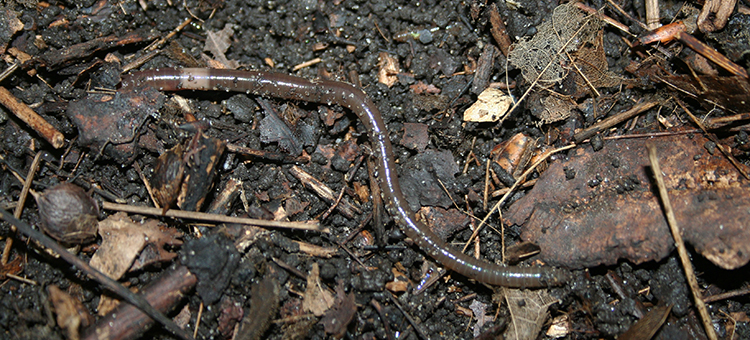CLOSURE ALERT: All CSWD facilities will be CLOSED on Friday, July 4 for the holiday.
Jumping Worms: What You Can Do

The Problem:
Jumping Worms (a.k.a. Snake Worms, Crazy Worms) rapidly consume plants and leaves, taking away nutrients and soil-securing roots, and leave behind loose castings (droppings) that wash away. Their castings can also change the pH balance of soils.
These worms can have widespread negative impacts on entire ecosystems. Frost kills the adults, but their eggs and cocoons can survive a Vermont winter.
How to Spot Jumping Worms:
- Jumping Worms are smooth, glossy, and dark gray/brown. Their clitellum (a smooth band around the worm’s body) is cloudy white to light gray and completely encircles the body.
- Jumping worms thrash around or move in a snake-like “S” fashion if disturbed.
- Adult Jumping Worm species can be one to eight inches long, reaching maturity in mid-summer. They may appear in groups by August and September.
- Their castings look like a layer of coarse coffee grounds where they’ve eaten the ground cover.
What to Do: Spread the word, not the worms!
Keep them out of your yard and garden
- Buy only red wriggler (Eisenia fetida) worms for vermicomposting and only from reputable sources.
- Do not release any purchased worms—for composting or for fishing bait—into the environment.
- Buy plants from a nursery or garden center that has a jumping worm prevention program in place.
- Buy soil, compost, mulch/wood chips from a compost facility or retailer that follows Jumping Worm prevention protocols.
If you see Jumping Worms or suspect you may have them:
- “Solarize” them: Recent evidence suggests that heating mulch and soil products or areas of infestation to 105 degrees F for three days will kill worms, cocoons, and eggs. This can be done by wrapping materials in plastic in direct sunlight and folding and “sealing” any openings so adults can’t escape.
- Handpick worms. Kill Jumping Worms by dropping them in a bucket of soapy water, alcohol, or vinegar with a lid or by sealing them in a plastic bag.
- If Jumping Worms are on your property, don’t share plants unless they are bare-root; solarize leaves and yard trimmings before taking them off-site or composting them on-site; wash tools and boots before using them elsewhere.
- Report observations of jumping worms at inaturalist.org
Once established, Jumping Worms will spread over time. By slowing their spread we can give researchers time to develop better strategies for minimizing or eliminating their impact.
How We Prevent The Spread of Jumping Worms
- We keep feedstocks and finished compost separate. Incoming leaves, wood chips, yard/garden trimmings that could contain jumping worms, cocoons, or eggs are kept a quarter mile from finished compost and soil products.
- Our hot process kills jumping worms, cocoons, and eggs. Our compost stays at 120 degrees F or higher for two to three months or longer and piles are routinely turned to ensure even heating. This kills jumping worms and their cocoons and eggs.
- We segregate and steam-clean equipment. We use separate equipment for handling pre- and post-hot-composting material. Any shared equipment is thoroughly steam-cleaned before it is moved between areas.
